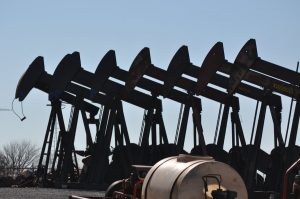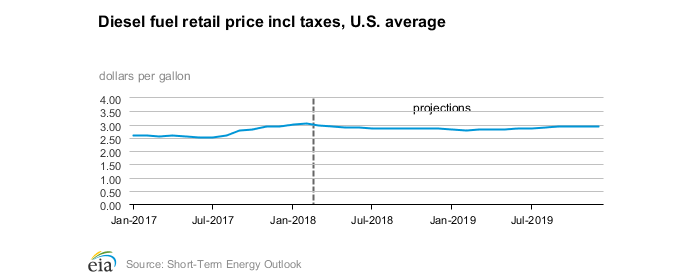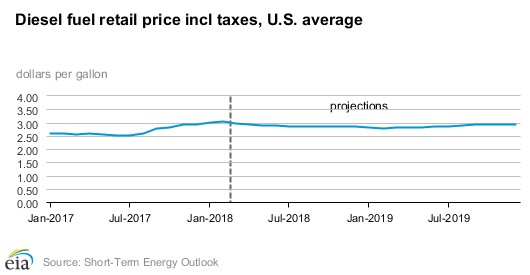A federal outlook for national average on-highway diesel prices predicts they will be higher this year and in 2019 than they were last year and in 2016. However, they should at least be fairly stable during this time, according to the latest Short Term Energy Outlook from the U.S. Energy Department.
It projects that trucking’s primary fuel will average $2.95 per gallon this year and bump slightly higher to $3.01 per gallon in 2019. While that’s an expected 11.2-percent hike for this year over last, it would represent just a 2-percent increase in 2019 over 2018. However, it’s less than the 14.8 percent jump in the average diesel price in 2017 over 2016.
The currently weekly average in the U.S. for on-highway diesel is just under $3 per gallon. It was expected to average $2.97 in the first quarter of this year before dropping to $2.89 in the second quarter. The third quarter average is expected to rise to $2.94 before finishing up at $3 per gallon in the fourth quarter.
The quarterly average range for diesel in 2019 is expected to range from a low of $2.96 in the first quarter to a high of $3.08 in the fourth quarter.
The trend for gasoline is similar, but at lesser prices and with smaller hikes. Regular grade is expected to average $2.57 per gallon this year and $2.58 per gallon in 2019. If such an increase happens this year, this would represent a 6.3-percent increase over 2017 and just a 0.4-precent gain in 2019 over 2018, far less than the 12.4-percent jump seen last year when compared to 2016.
Enjoying our insights?
Subscribe to our newsletter to keep up with the latest industry trends and developments.
Stay Informed
Oil Pumpjacks
Driving the price of both fuels higher will be slightly increased crude oil prices. Benchmark North Sea Brent crude oil spot prices averaged $64 per barrel in December, an almost $2 per barrel increase from the November average and the highest monthly average since November 2014.
Brent crude oil prices averaged $54 per barrel in 2017 and are forecast to average $60 per barrel this year and $61 per barrel in 2019. West Texas Intermediate crude oil spot prices are forecast to average $4 per barrel less than Brent prices in both 2018 and 2019.
The report also noted the slight increase in fuel and oil prices is expected as U.S. crude oil production is expected to keep moving higher.
The U.S. produced an estimated 9.3 million barrels per day in 2017, with an estimated average of 9.9 million barrels per day in December. U.S. crude oil production is forecast to increase to an average 10.3 million barrels per day this year, which would mark the highest annual average production in U.S. history, surpassing the previous record of 9.6 million barrels per day set in 1970.
The Energy Department has forecast production to increase to an average of 10.8 million barrels per day in 2019 and to surpass 11 million barrels per day in November 2019.
Despite the increased production, one reason fuel prices likely won’t be moving lower this year or next is that worldwide consumption of petroleum and other liquid fuels grew by 1.4 million barrels per day in 2017, reaching an average of 98.4 million barrel per days for the year.
Although the rate of consumption growth slowed in 2017 compared with 2016, the department said it expects that worldwide consumption growth will average 1.7 million barrels per day this year and almost 1.7 million barrels per day in 2019, driven by the countries in mainly in Asia, Africa and South America, while global oil inventories will rise just a fraction after falling slightly in 2017.






















